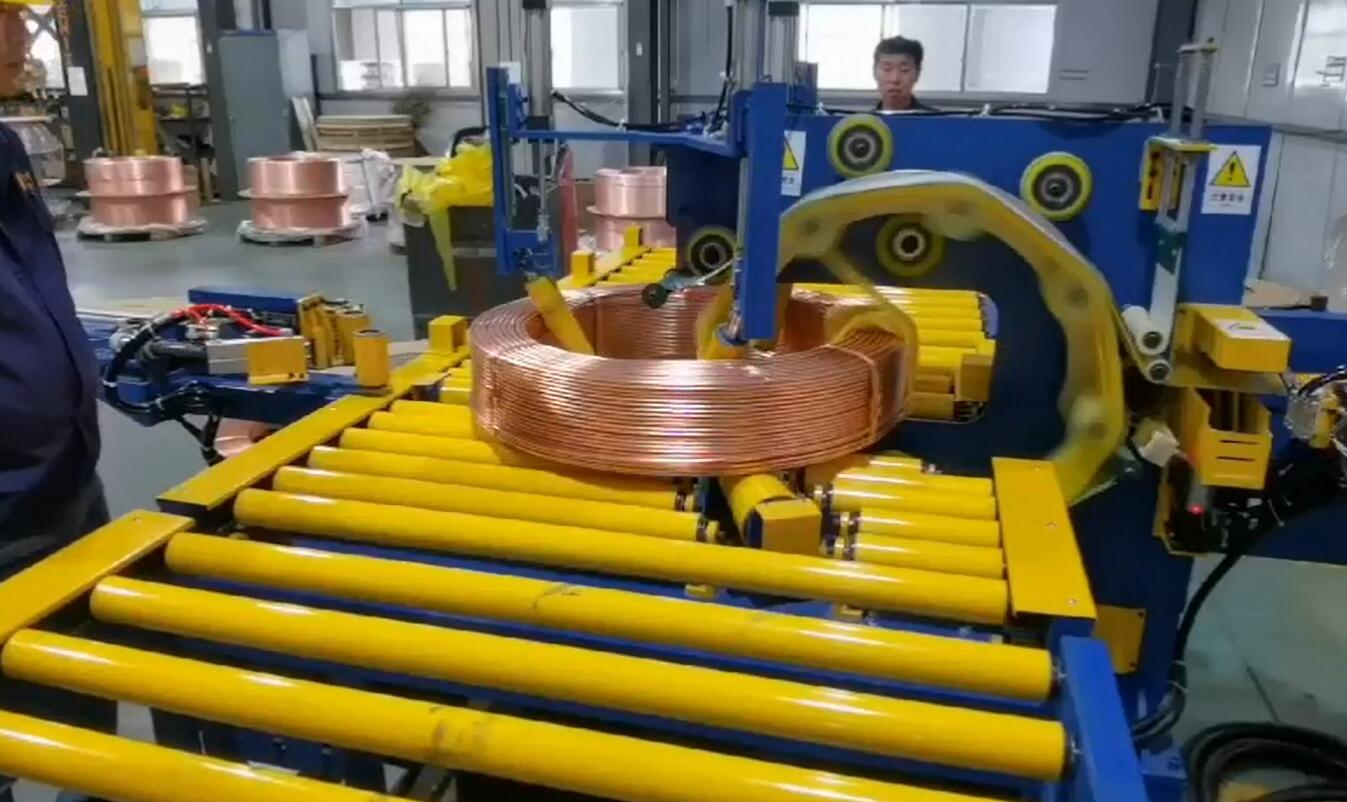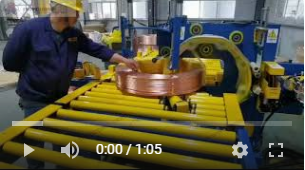Optimizing Copper Coil Packaging: A Technical Deep Dive into Automated Stretch Wrapping
Copper, in its various forms like tubes, wires, and strips, is a cornerstone material across demanding industries, from electrical power distribution to intricate HVAC systems. Protecting these high-value coils during handling, storage, and transit is paramount. Traditional manual or semi-automated packaging methods often introduce inconsistencies, risk damage, and consume significant labor resources. This article explores the technical advantages, design considerations, and operational benefits of adopting fully automated solutions like the FPC series orbital stretch wrapper for copper coil packaging.
1. The Challenge: Safeguarding Valuable Copper Coils
Copper coils present unique packaging challenges:
- Surface Sensitivity: Prone to scratches, dents, and contamination, which can compromise performance, especially in electrical applications.
- Oxidation Risk: Exposure to moisture and atmospheric elements can lead to corrosion, affecting conductivity and appearance.
- Deformation Potential: Improper handling or inadequate support can cause coils to deform, leading to material waste.
- Inconsistent Manual Wrapping: Manual application of stretch film often results in variable tension, uneven coverage, and potential film tears, offering suboptimal protection.
- Labor Intensity & Cost: Manual packaging is time-consuming and physically demanding, contributing significantly to operational costs.
Addressing these points requires a consistent, reliable, and efficient packaging method, making automation a compelling proposition.
2. The Automated Solution: FPC Series Orbital Stretch Wrapper
The FPC series copper coil packing machine exemplifies a specialized automated system engineered for the rigorous demands of packaging copper coils, cable coils, steel wire, and similar annular products. By employing orbital stretch wrapping technology, these machines deliver secure, uniform, and highly efficient packaging results.
(Image Placeholder: Insert image of the FPC series machine wrapping a copper coil. Alt Text: FPC Series automatic orbital stretch wrapper packaging a large copper tube coil.)

3. Operating Principle, Structure, and Key Components
Understanding the machine's design and operation reveals its advantages:
- Structural Design: Typically features a robust steel frame housing the core wrapping mechanism, integrated conveyors or tilting systems for coil handling, and safety guarding. The design prioritizes stability during the high-speed rotation of the wrapping ring.
- Orbital Wrapping Mechanism: The heart of the system. The copper coil is positioned centrally (often via automated conveyors or a C-hook tilter). A rotating ring, equipped with the stretch film carriage, orbits through the eye of the coil while the coil itself may remain stationary or rotate slowly depending on the required wrapping pattern. This orbital motion ensures complete coverage around the coil's toroidal shape.
- Film Carriage & Pre-Stretch Unit: This component holds the film roll (LLDPE, VCI film) and incorporates a powered pre-stretch system. By stretching the film before application (often adjustable from 150% to over 300%), it maximizes film yield, enhances load containment force, and reduces material costs. Precise tension control is critical for protecting softer copper tubes from being crushed.
- PLC Control System & HMI: A Programmable Logic Controller (PLC) governs all machine functions – ring speed, conveyor movement, film tension, number of wraps, overlap percentage, and cut/clamp sequences. A user-friendly Human Machine Interface (HMI) allows operators to easily select recipes, adjust parameters, and monitor system status and diagnostics.
- Automatic Film Cut & Clamp/Wipe: Upon cycle completion, the system automatically cuts the stretch film and clamps the leading edge for the next cycle, or employs a wiping mechanism to press the film tail against the coil, ensuring a clean finish without manual intervention.
- Conveying and Handling Integration: Designed for seamless integration into production lines. Input and output conveyors, tilting devices (for eye-to-sky orientation changes), and potential robotic interfaces enable fully automated loading and unloading.
4. Technical Specifications Overview
While customizable, typical specifications for FPC series machines include:
- Applicable Products: Copper tube coils, copper wire coils, copper strips, aluminum coils, cable coils, steel wire/coils, PC strand.
- Coil Dimensions:
- Outer Diameter (OD): 600mm - 2000mm (Example range)
- Inner Diameter (ID): 300mm - 1500mm (Example range)
- Width: 100mm - 800mm (Example range)
- Coil Weight Capacity: Up to 3000 kg (or as specified)
- Wrapping Materials:
- LLDPE Stretch Film (Linear Low-Density Polyethylene)
- VCI Stretch Film (Volatile Corrosion Inhibitor) - Recommended for enhanced corrosion protection.
- Paper or other protective layers can often be applied simultaneously.
- Wrapping Efficiency: 20 - 60 seconds per coil (dependent on coil size, wraps required, and automation level).
- Ring Rotation Speed: Variable, typically 40 - 90 RPM (adjustable via HMI).
- Film Pre-Stretch Ratio: Adjustable, typically up to 300%.
- Power Requirements: 380V/50Hz, 3-Phase (or as per regional standards).
- Control System: Siemens/Allen-Bradley PLC & HMI (Common options).
Technical Data Comparison: Automated vs. Manual Wrapping
| Feature | Automated Orbital Wrapper (FPC Series) | Manual Wrapping |
|---|---|---|
| Cycle Time/Coil | 20-60 seconds | 5-15 minutes (highly variable) |
| Labor Required | 1 Operator (Monitoring/Loading) | 1-2 Operators (Full-time) |
| Film Usage | Optimized via Pre-stretch (up to 300%) | High, inconsistent stretch |
| Consistency | High (Uniform tension & overlap) | Low (Operator dependent) |
| Protection Level | Excellent (Tight, full coverage, VCI) | Variable, potential gaps |
| Safety | High (Guarded, reduced handling) | Moderate (Manual handling risk) |
| Throughput | High | Low |
5. Quantifiable Benefits for Industrial Operations
Transitioning to automated wrapping delivers measurable improvements:
- Superior Product Protection: Consistent, tightly wrapped coils are shielded from dust, moisture, abrasion, and shifting during transit. VCI film integration proactively combats corrosion. This directly reduces scrap rates and customer claims.
- Drastic Throughput Increase: Automated cycles are significantly faster and more predictable than manual methods, boosting overall packaging line capacity. As cited by industry resources like Packaging Digest, automation can yield throughput gains exceeding 50-70% in wrapping applications.
- Significant Labor Cost Reduction: Reallocates workforce from strenuous manual wrapping to more skilled tasks, improving operational efficiency and reducing labor expenditure per unit packaged.
- Optimized Material Consumption: Pre-stretch technology substantially lowers stretch film consumption per coil compared to manual wrapping, leading to direct cost savings and environmental benefits.
- Enhanced Workplace Safety: Automating the handling and wrapping of heavy, potentially sharp-edged coils minimizes risks of strains, cuts, and other manual handling injuries.
- Professional Package Presentation: Uniformly wrapped coils project a higher quality image, enhancing brand reputation and customer perception upon receipt.
6. Integration and User Experience Insights
From a user perspective, modern automated wrappers offer:
- Ease of Use: Intuitive HMI screens simplify operation, recipe selection, and troubleshooting. Minimal training is typically required for operators.
- Flexibility: Ability to store multiple wrapping programs for different coil sizes and types, allowing quick changeovers.
- Reliability: Designed for industrial environments, utilizing durable components to ensure high uptime and consistent performance. Preventative maintenance schedules are often prompted by the control system.
- Data Logging: Advanced systems may offer production data logging (cycles completed, film usage, fault history), aiding in performance analysis and OEE (Overall Equipment Effectiveness) calculations.
(Image Placeholder: Insert image of the HMI screen of the FPC series machine. Alt Text: HMI touch screen interface for the FPC Series copper coil wrapper showing parameter settings.)
7. Fhope Group: Focus on Packaging Line Optimization
Companies like Fhope Group specialize in developing comprehensive packaging solutions. Their focus extends beyond the wrapper itself to include efficient conveying systems, coil tilting and centering devices, and robust machine construction aimed at maximizing reliability and minimizing packaging defects. The FPC series machine reflects this philosophy, providing an integrated solution tailored to the specific needs of copper material producers and distributors.
Conclusion: Elevating Copper Coil Packaging Standards
Automated orbital stretch wrapping systems, exemplified by the FPC series, represent a significant technological advancement over traditional methods for packaging copper coils. By offering unparalleled protection, substantial efficiency gains, reduced operational costs, and improved safety, these machines are crucial investments for any operation handling valuable copper materials. Adopting this technology not only streamlines the packaging process but also ensures product integrity throughout the supply chain, aligning with best practices for quality assurance and operational excellence in industrial distribution. For further information on material handling advancements, consult resources like Material Handling Engineering or the Material Handling Institute (MHI).


